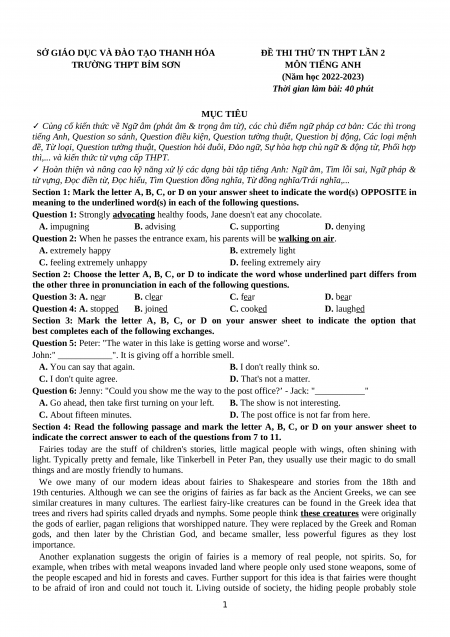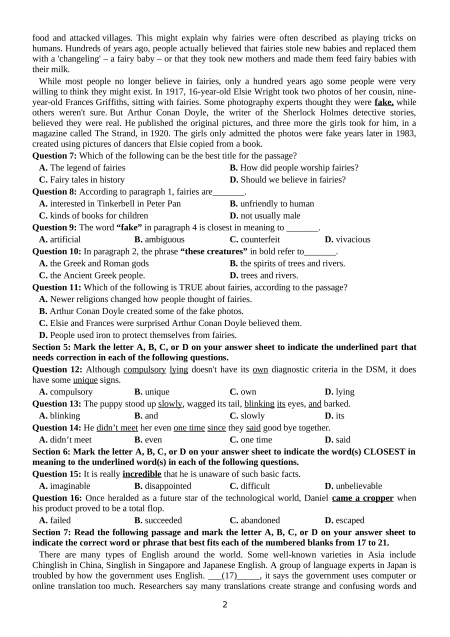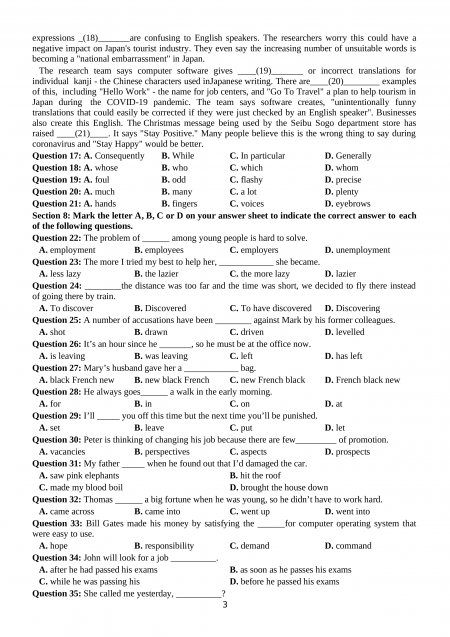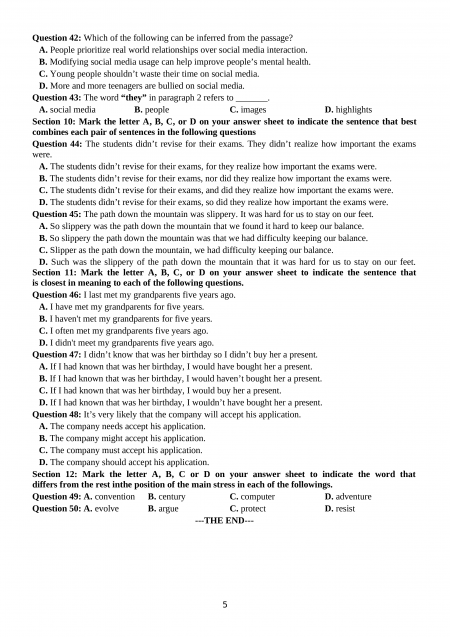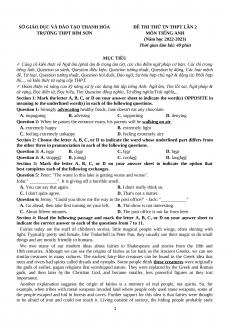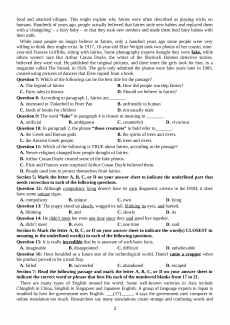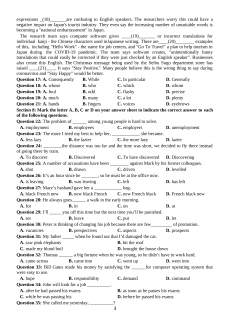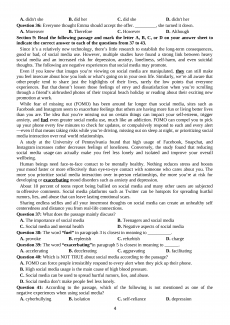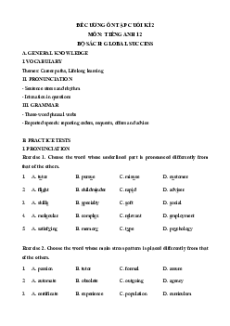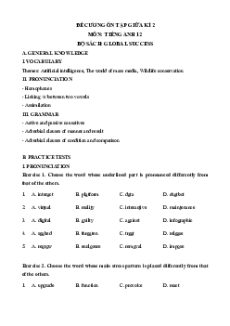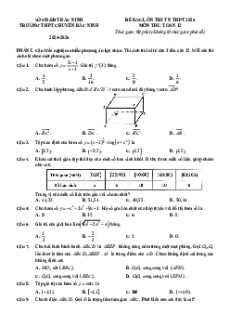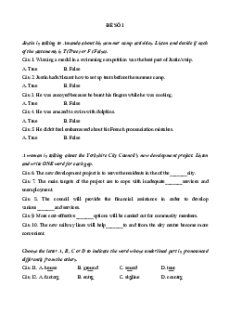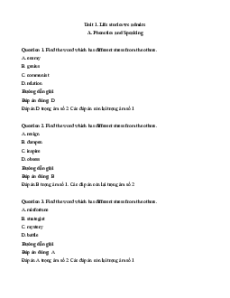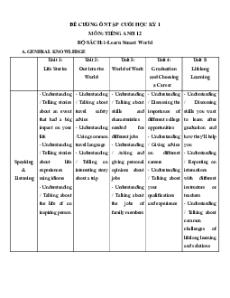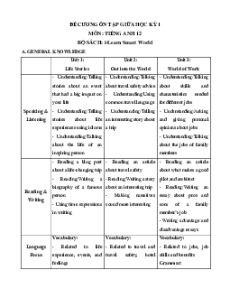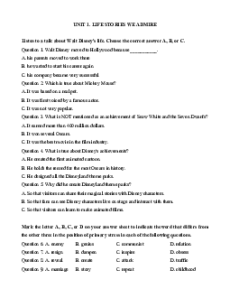SỞ GIÁO DỤC VÀ ĐÀO TẠO THANH HÓA
ĐỀ THI THỬ TN THPT LẦN 2
TRƯỜNG THPT BỈM SƠN MÔN TIẾNG ANH (Năm học 2022-2023)
Thời gian làm bài: 40 phút MỤC TIÊU
✓ Củng cố kiến thức về Ngữ âm (phát âm & trọng âm từ), các chủ điểm ngữ pháp cơ bản: Các thì trong
tiếng Anh, Question so sánh, Question điều kiện, Question tường thuật, Question bị động, Các loại mệnh
đề, Từ loại, Question tường thuật, Question hỏi đuôi, Đảo ngữ, Sự hòa hợp chủ ngữ & động từ, Phối hợp
thì,... và kiến thức từ vựng cấp THPT.
✓ Hoàn thiện và nâng cao kỹ năng xử lý các dạng bài tập tiếng Anh: Ngữ âm, Tìm lỗi sai, Ngữ pháp &
từ vựng, Đọc điền từ, Đọc hiểu, Tìm Question đồng nghĩa, Từ đồng nghĩa/Trái nghĩa,...
Section 1: Mark the letter A, B, C, or D on your answer sheet to indicate the word(s) OPPOSITE in
meaning to the underlined word(s) in each of the following questions.
Question 1: Strongly advocating healthy foods, Jane doesn't eat any chocolate. A. impugning B. advising C. supporting D. denying
Question 2: When he passes the entrance exam, his parents will be walking on air. A. extremely happy B. extremely light
C. feeling extremely unhappy
D. feeling extremely airy
Section 2: Choose the letter A, B, C, or D to indicate the word whose underlined part differs from
the other three in pronunciation in each of the following questions. Question 3: A. near B. clear C. fear D. bear Question 4: A. stopped B. joined C. cooked D. laughed
Section 3: Mark the letter A, B, C, or D on your answer sheet to indicate the option that
best completes each of the following exchanges.
Question 5: Peter: "The water in this lake is getting worse and worse".
John:" ____________". It is giving off a horrible smell.
A. You can say that again.
B. I don't really think so.
C. I don't quite agree.
D. That's not a matter.
Question 6: Jenny: "Could you show me the way to the post office?’ - Jack: "___________"
A. Go ahead, then take first turning on your left.
B. The show is not interesting.
C. About fifteen minutes.
D. The post office is not far from here.
Section 4: Read the following passage and mark the letter A, B, C, or D on your answer sheet to
indicate the correct answer to each of the questions from 7 to 11.
Fairies today are the stuff of children's stories, little magical people with wings, often shining with
light. Typically pretty and female, like Tinkerbell in Peter Pan, they usually use their magic to do small
things and are mostly friendly to humans.
We owe many of our modern ideas about fairies to Shakespeare and stories from the 18th and
19th centuries. Although we can see the origins of fairies as far back as the Ancient Greeks, we can see
similar creatures in many cultures. The earliest fairy-like creatures can be found in the Greek idea that
trees and rivers had spirits called dryads and nymphs. Some people think these creatures were originally
the gods of earlier, pagan religions that worshipped nature. They were replaced by the Greek and Roman
gods, and then later by the Christian God, and became smaller, less powerful figures as they lost importance.
Another explanation suggests the origin of fairies is a memory of real people, not spirits. So, for
example, when tribes with metal weapons invaded land where people only used stone weapons, some of
the people escaped and hid in forests and caves. Further support for this idea is that fairies were thought
to be afraid of iron and could not touch it. Living outside of society, the hiding people probably stole 1
food and attacked villages. This might explain why fairies were often described as playing tricks on
humans. Hundreds of years ago, people actually believed that fairies stole new babies and replaced them
with a 'changeling' – a fairy baby – or that they took new mothers and made them feed fairy babies with their milk.
While most people no longer believe in fairies, only a hundred years ago some people were very
willing to think they might exist. In 1917, 16-year-old Elsie Wright took two photos of her cousin, nine-
year-old Frances Griffiths, sitting with fairies. Some photography experts thought they were fake, while
others weren't sure. But Arthur Conan Doyle, the writer of the Sherlock Holmes detective stories,
believed they were real. He published the original pictures, and three more the girls took for him, in a
magazine called The Strand, in 1920. The girls only admitted the photos were fake years later in 1983,
created using pictures of dancers that Elsie copied from a book.
Question 7: Which of the following can be the best title for the passage?
A. The legend of fairies
B. How did people worship fairies?
C. Fairy tales in history
D. Should we believe in fairies?
Question 8: According to paragraph 1, fairies are_______.
A. interested in Tinkerbell in Peter Pan B. unfriendly to human
C. kinds of books for children D. not usually male
Question 9: The word “fake” in paragraph 4 is closest in meaning to _______. A. artificial B. ambiguous C. counterfeit D. vivacious
Question 10: In paragraph 2, the phrase “these creatures” in bold refer to_______.
A. the Greek and Roman gods
B. the spirits of trees and rivers.
C. the Ancient Greek people. D. trees and rivers.
Question 11: Which of the following is TRUE about fairies, according to the passage?
A. Newer religions changed how people thought of fairies.
B. Arthur Conan Doyle created some of the fake photos.
C. Elsie and Frances were surprised Arthur Conan Doyle believed them.
D. People used iron to protect themselves from fairies.
Section 5: Mark the letter A, B, C, or D on your answer sheet to indicate the underlined part that
needs correction in each of the following questions.
Question 12: Although compulsory lying doesn't have its own diagnostic criteria in the DSM, it does have some unique signs. A. compulsory B. unique C. own D. lying
Question 13: The puppy stood up slowly, wagged its tail, blinking its eyes, and barked. A. blinking B. and C. slowly D. its
Question 14: He didn’t meet her even one time since they said good bye together. A. didn’t meet B. even C. one time D. said
Section 6: Mark the letter A, B, C, or D on your answer sheet to indicate the word(s) CLOSEST in
meaning to the underlined word(s) in each of the following questions.
Question 15: It is really incredible that he is unaware of such basic facts. A. imaginable B. disappointed C. difficult D. unbelievable
Question 16: Once heralded as a future star of the technological world, Daniel came a cropper when
his product proved to be a total flop. A. failed B. succeeded C. abandoned D. escaped
Section 7: Read the following passage and mark the letter A, B, C, or D on your answer sheet to
indicate the correct word or phrase that best fits each of the numbered blanks from 17 to 21.
There are many types of English around the world. Some well-known varieties in Asia include
Chinglish in China, Singlish in Singapore and Japanese English. A group of language experts in Japan is
troubled by how the government uses English. ___(17)_____, it says the government uses computer or
online translation too much. Researchers say many translations create strange and confusing words and 2
expressions _(18)_______are confusing to English speakers. The researchers worry this could have a
negative impact on Japan's tourist industry. They even say the increasing number of unsuitable words is
becoming a "national embarrassment" in Japan.
The research team says computer software gives ____(19)_______ or incorrect translations for
individual kanji - the Chinese characters used inJapanese writing. There are____(20)________ examples
of this, including "Hello Work" - the name for job centers, and "Go To Travel" a plan to help tourism in
Japan during the COVID-19 pandemic. The team says software creates, "unintentionally funny
translations that could easily be corrected if they were just checked by an English speaker". Businesses
also create this English. The Christmas message being used by the Seibu Sogo department store has
raised ____(21)____. It says "Stay Positive." Many people believe this is the wrong thing to say during
coronavirus and "Stay Happy" would be better.
Question 17: A. Consequently B. While C. In particular D. Generally Question 18: A. whose B. who C. which D. whom Question 19: A. foul B. odd C. flashy D. precise Question 20: A. much B. many C. a lot D. plenty Question 21: A. hands B. fingers C. voices D. eyebrows
Section 8: Mark the letter A, B, C or D on your answer sheet to indicate the correct answer to each of the following questions.
Question 22: The problem of ______ among young people is hard to solve. A. employment B. employees C. employers D. unemployment
Question 23: The more I tried my best to help her, ____________ she became. A. less lazy B. the lazier C. the more lazy D. lazier
Question 24: ________the distance was too far and the time was short, we decided to fly there instead of going there by train. A. To discover B. Discovered C. To have discovered D. Discovering
Question 25: A number of accusations have been ________ against Mark by his former colleagues. A. shot B. drawn C. driven D. levelled
Question 26: It’s an hour since he _______, so he must be at the office now. A. is leaving B. was leaving C. left D. has left
Question 27: Mary’s husband gave her a ____________ bag. A. black French new B. new black French C. new French black D. French black new
Question 28: He always goes______ a walk in the early morning. A. for B. in C. on D. at
Question 29: I’ll _____ you off this time but the next time you’ll be punished. A. set B. leave C. put D. let
Question 30: Peter is thinking of changing his job because there are few_________ of promotion. A. vacancies B. perspectives C. aspects D. prospects
Question 31: My father _____ when he found out that I’d damaged the car. A. saw pink elephants B. hit the roof C. made my blood boil
D. brought the house down
Question 32: Thomas ______ a big fortune when he was young, so he didn’t have to work hard. A. came across B. came into C. went up D. went into
Question 33: Bill Gates made his money by satisfying the ______for computer operating system that were easy to use. A. hope B. responsibility C. demand D. command
Question 34: John will look for a job __________.
A. after he had passed his exams
B. as soon as he passes his exams
C. while he was passing his
D. before he passed his exams
Question 35: She called me yesterday, __________? 3 A. didn't she B. did her C. did she D. didn't her
Question 36: Everyone thought Emma should accept the offer. _________, she turned it down. A. Moreover B. Therefore C. However D. Although
Section 9: Read the following passage and mark the letter A, B, C, or D on your answer sheet to
indicate the correct answer to each of the questions from 37 to 43.
Since it’s a relatively new technology, there’s little research to establish the long-term consequences,
good or bad, of social media use. However, multiple studies have found a strong link between heavy
social media and an increased risk for depression, anxiety, loneliness, self-harm, and even suicidal
thoughts. The following are negative experiences that social media may promote.
Even if you know that images you’re viewing on social media are manipulated, they can still make
you feel insecure about how you look or what’s going on in your own life. Similarly, we’re all aware that
other people tend to share just the highlights of their lives, rarely the low points that everyone
experiences. But that doesn’t lessen those feelings of envy and dissatisfaction when you’re scrolling
through a friend’s airbrushed photos of their tropical beach holiday or reading about their exciting new promotion at work.
While fear of missing out (FOMO) has been around far longer than social media, sites such as
Facebook and Instagram seem to exacerbate feelings that others are having more fun or living better lives
than you are. The idea that you’re missing out on certain things can impact your self-esteem, trigger
anxiety, and fuel even greater social media use, much like an addiction. FOMO can compel you to pick
up your phone every few minutes to check for updates, or compulsively respond to each and every alert
—even if that means taking risks while you’re driving, missing out on sleep at night, or prioritizing social
media interaction over real world relationships.
A study at the University of Pennsylvania found that high usage of Facebook, Snapchat, and
Instagram increases rather decreases feelings of loneliness. Conversely, the study found that reducing
social media usage can actually make you feel less lonely and isolated and improve your overall wellbeing.
Human beings need face-to-face contact to be mentally healthy. Nothing reduces stress and boosts
your mood faster or more effectively than eye-to-eye contact with someone who cares about you. The
more you prioritize social media interaction over in-person relationships, the more you’re at risk for
developing or exacerbating mood disorders such as anxiety and depression.
About 10 percent of teens report being bullied on social media and many other users are subjected
to offensive comments. Social media platforms such as Twitter can be hotspots for spreading hurtful
rumors, lies, and abuse that can leave lasting emotional scars.
Sharing endless selfies and all your innermost thoughts on social media can create an unhealthy self
centeredness and distance you from real-life connections.
Question 37: What does the passage mainly discuss?
A. The importance of social media
B. Teenagers and social media
C. Social media and mental health
D. Negative aspects of social media
Question 38: The word “fuel” in paragraph 3 is closest in meaning to __________. A. provoke B. replenish C. refurbish D. charge
Question 39: The word “exacerbating”in paragraph 5 is closest in meaning to ______. A. accelerating B. decelerating C. aggravating D. facilitating
Question 40: Which is NOT TRUE about social media according to the passage?
A. FOMO can force people irresistibly respond to every alert when they pick up their phone.
B. High social media usage is the main cause of high blood pressure.
C. Social media can be used to spread hurtful rumors, lies, and abuse.
D. Social media don’t make people feel less lonely.
Question 41: According to the passage, which of the following is not mentioned as one of the
negative experiences when using social media? A. cyberbullying B. isolation C. self-reliance D. depression 4
Bộ 50 Đề thi thử Tiếng Anh THPT Quốc gia năm 2023 chọn lọc từ các trường
CÁCH MUA:
- B1: Gửi phí vào TK:
1133836868- CT TNHH DAU TU VA DV GD VIETJACK - Ngân hàng MB (QR) - B2: Nhắn tin tới Zalo VietJack Official ( nhấn vào đây ) để xác nhận thanh toán và tải tài liệu - giáo án
Liên hệ ngay Hotline hỗ trợ: 084 283 45 85
Đề thi được cập nhật liên tục trong gói này từ nay đến hết tháng 6/2023. Chúng tôi đảm bảo đủ số lượng đề đã cam kết hoặc có thể nhiều hơn, tất cả có BẢN WORD, LỜI GIẢI CHI TIẾT và tải về dễ dàng.
Để tải tài liệu gốc về máy bạn click vào nút Tải Xuống ở trên!
Thuộc bộ (mua theo bộ để tiết kiệm hơn):
- Bộ 50 Đề thi thử THPT Quốc Gia Tiếng Anh năm 2023 chọn lọc từ các trường bản word có lời giải chi tiết:
+ Đề thi thử THPT Quốc Gia Tiếng Anh năm 2023 trường THPT Yên Thế - Bắc Giang;
+ Đề thi thử THPT Quốc Gia Tiếng Anh năm 2023 trường THPT Ninh Giang - Hải Dương;
+ Đề thi thử THPT Quốc Gia Tiếng Anh năm 2023 trường Sở GD - ĐT Bắc Ninh;
+ Đề thi thử THPT Quốc Gia Tiếng Anh năm 2023 THPT Hàm Long - Bắc Ninh;
+ Đề thi thử THPT Quốc Gia Tiếng Anh năm 2023 trường THPT Lý Thái Tổ - Bắc Ninh.
…..……………………
- Mua trọn bộ sẽ tiết kiệm hơn tải lẻ 50%.
Đánh giá
4.6 / 5(1074 )Trọng Bình
Giúp ích cho tôi rất nhiều
Duy Trần
Rất thích tài liệu bên VJ soạn (bám sát chương trình dạy)
TÀI LIỆU BỘ BÁN CHẠY MÔN Tiếng Anh
Xem thêmTÀI LIỆU BỘ BÁN CHẠY Tốt nghiệp THPT
Xem thêmTài liệu bộ mới nhất





